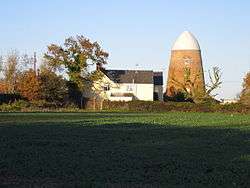Clavering Windmills
Clavering Windmills are a pair of Grade II listed[1][2] Tower mills at Clavering, Essex, England which have both been converted to residential use. They are named North Mill and South Mill. A third mill existed in Clavering until the mid-nineteenth century, known as Clavering Mill.
| North Mill, Clavering | |
|---|---|
 North Mill, November 2006 | |

| |
| Origin | |
| Mill name | North Mill |
| Grid reference | TL 466 328 |
| Coordinates | 51.974°N 0.136°E |
| Operator(s) | Private |
| Year built | 1811 |
| Information | |
| Purpose | Corn mill |
| Type | Tower mill |
| Storeys | Five storeys |
| No. of sails | Four sails |
| Type of sails | Single Patent sails |
| Auxiliary power | Oil engine |
| No. of pairs of millstones | Three pairs |
| South Mill, Clavering | |
|---|---|
 South Mill, November 2006 | |

| |
| Origin | |
| Mill name | South Mill |
| Grid reference | TL 465 326 |
| Coordinates | 51.973°N 0.133°E |
| Operator(s) | Private |
| Year built | 1757 |
| Information | |
| Purpose | Corn mill |
| Type | Tower mill |
| Storeys | Four storeys |
| No. of sails | Four sails |
| Type of sails | Spring sails |
| Winding | Fantail |
| No. of pairs of millstones | Two pairs |
History
Clavering Mill
Clavering Mill was a Post mill. It was marked on a map dated c.1625 and then in the ownership of Sir Francis Barrington. In 1702 it was conveyed to Sir Charles Barrington. The mill was marked on Warburton, Bland and Smyth’s map of 1724. It was marked on a plan of Clavering dated 1783 and also on the 1840 Tithe map of Clavering. White’s Directory of 1848 records three millers in Clavering, the last date at which the post mill can be assumed to have been standing.[3]
North Mill
North Mill was built for James Pavitt in 1811, working in conjunction with the post mill until 1845. A 16 horsepower (12 kW) oil engine was installed in 1919 by Thomas Hunt, the Soham millwright. The sails were removed about this time, but the mill worked by the engine for many years.[3]
Description
Clavering Mill
No details are known of this mill, although it would have had Common sails when built. It is not known whether there was a roundhouse or not.[3]
North Mill
North Mill is a five-storey tower mill with a beehive cap, winded by a fantail. It had four Single Patent sails, which rotated clockwise. The Upright Shaft is wooden, as is the clasp arm Great Spur Wheel, which drove three pairs of millstones overdrift.[3]
South mill
South Mill is a four-storey tower mill with a beehive cap with a gallery. It was winded by a fantail It had four Single Spring sails. The mill drove two pairs of French Burr millstones.[3]
Millers
Post
- William Hill 1702
- Thomas Nottage 1802
- James Pavitt 1804 - 1845
South
- Henry Salmon 1772 - 1804
- Henry Moore 1840–1850
- William Overill 1849
- Robert Spencer 1871
- William Caton 1906 - 1919
North
- James Pavitt 1811–1845
- James Pavitt Jr 1845 - 1850
- Spencer 1879
- William Caton 1906 –
- A E Caton 1935
References for above:-[3]
External links
- Windmill World webpage on South Mill
- Windmill World webpage on North Mill
References
- Historic England. "Windmill at The Mills, Mill End, Clavering (1322464)". National Heritage List for England. Retrieved 2008-07-22.
- Historic England. "Windmill approximately 180 metres north east of The Mills and shop, Mill End, Clavering (1112432)". National Heritage List for England. Retrieved 2008-07-22.
- Farries, Kenneth (1984). Essex Windmills, Millers and Millwrights - Volume Three - A Review by Parishes, A-E. Edinburgh: Charles Skilton. pp. 81–84. ISBN 0-284-98642-9.